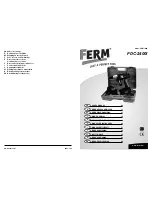
Ferm
95
•
Når der skal bores i bløde materialer som træ eller plastic, drejes hammer/bor-knappen (6)
med uret, indtil indikatoren er ud for symbolet ‘BOR’. Brug et metalbor.
•
Skal der bores i hårdt materiale som sten eller beton, drejes knappen mod uret, til
indikatoren er ud for symbolet ‘HAMMER’. Brug her et bor med hårdmetalskær.
Kontroller jævnligt borepatronen for beskadigelse.
Brug eventuelt kølemiddel. Når der bores i vægge, skal man passe på ikke at komme
til at bore i ledninger eller vandrør. Spørg forhandleren om råd vedrørende brug.
Tænd og sluk
Fig. E
•
Tryk afbryderen (2) ind. Maskinens omdrejningshastighed kan reguleres ved at trykke
mere eller mindre på afbryderen.
•
Når afbryderen (2) slippes, stopper maskinen straks.
•
Sæt knappen til rotationsretning (1) i midterposition for at låse maskinen, så den ikke kan
tændes på afbryderen.
Læg ikke maskinen væk, før der er stoppet helt. Læg ikke maskinen på en støvet overflade.
Støvpartikler kan trænge ind i maskinen.
Brug kun maskinen, hvis knappen til rotationsretning (2) er helt i en af positionerne.
Brug ikke maskinen, hvis denne knap er i neutral position.
Opladning af batteri
Fig. F
Den medfølgende batterilader er kun beregnet til opladning af batterierne til FDC-2400 I.
•
Sæt batteriet (3) i batteriladeren (9) som vist på illustrationen.
•
Sæt stikket til batteriladeren i en stikkontakt. Den røde lampe for “lynopladning” (10) lyser.
•
Når den grønne lampe (11) lyser, er batteriet ladet op og klar til brug.
Batteriladeren må kun bruges i tørre rum ved en temperatur på mellem 10°C og
40°C.
Batteriet til denne boremaskine er ikke ladet op. Før maskinen bruges første gang, skal
batteriet lades op i 1 til 2 timer, så det når op på fuld kapacitet. Batteriets maksimale kapacitet
nås først, når det er blevet ladet op 4 til 5 gange.
Hvis accu boremaskinen ikke skal bruges i længere tid, skal batteriet lades op, før
det gemmes væk. Fra tid til anden skal batteriet lades en smule op, så man undgår,
at det aflades helt. Batteriet skal opbevares særskilt i plastickufferten.
DK
Ferm
Wear ear and eye protection
Never throw batteries into open fire
Always recycle batteries
Faulty and/or discarded electrical or electronic apparatus have to be collected at
the appropriate recycling locations.
Important safety advice concerning the battery pack & battery charger
If you should come into contact with any acid from the Battery pack, wash the
affected parts with water immediately. If acid should come into contact with the eyes,
rinse them immediately with water and seek medical advice as soon as possible.
1.
Before using both the battery pack and the battery charger, make sure you have read and
understood the operating instructions and safety information.
2.
Only use the battery pack with the battery charger provided – using other chargers could
be dangerous.
3.
Keep the battery pack, tool and battery charger away from damp and wet conditions.
4.
Before using the battery charger, check all wires are properly connected.
5.
If any wires on the charger are damaged, do not use it until these have been replaced.
6.
When the charger is not in use it should not be plugged in. When unplugging, do not pull the
plug out by the cable.
7.
If the charger breaks down or suffers from other technical problems, take it to a recognised
dealership to be checked before using it again. Any damaged parts must be replaced.
8.
Take care when handling the battery pack, do not drop it or knock it against other things.
9.
Never attempt to repair the battery charger or battery pack yourself; this can be extremely
dangerous. Repairs should always be carried out by a recognised dealership.
10. Always unplug the charger before cleaning or carrying out any other maintenance on it.
11. Do not attempt to charge the battery pack in temperatures of below 10 degrees or above 40
degrees centigrade.
12. The air vents on the battery charger must be kept unblocked.
13. The battery pack must not be short-circuited.
When an apparatus short-circuits, the strength of the electric current is increased.
This can cause the apparatus to over heat, catch fire or even explode, causing
damage and also endangering the operator.
To avoid this:
•
Firstly do not connect any wires to the terminals of the battery pack;
•
Ensure that no metal objects (nails, coins, paper-clips) are caught in the opening of the
battery pack;
•
Do not expose the battery pack to water or rain.
6
UK





















